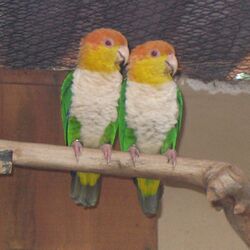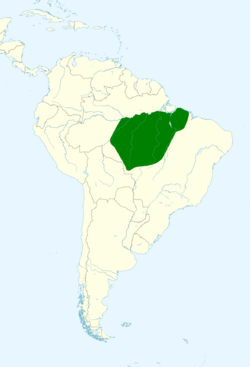Biology:Green-thighed parrot
| Green-thighed parrot | |
|---|---|

| |
| Scientific classification | |
| Domain: | Eukaryota |
| Kingdom: | Animalia |
| Phylum: | Chordata |
| Class: | Aves |
| Order: | Psittaciformes |
| Family: | Psittacidae |
| Genus: | Pionites |
| Species: | P. leucogaster
|
| Binomial name | |
| Pionites leucogaster (Kuhl, 1820)
| |

| |
The green-thighed parrot (Pionites leucogaster), also known as the eastern white-bellied parrot, is a species of parrot in the family Psittacidae.[2] The species was previously known as the white-bellied parrot (or white-bellied caique in aviculture) and contained three subspecies including the nominate race,[3] but recent morphological work suggested the species should be split into three:[4]
- green-thighed parrot or eastern white-bellied parrot (Pionites leucogaster)
- black-legged parrot or western white-bellied parrot (Pionites xanthomerius)
- yellow-tailed parrot or central white-bellied parrot (Pionites xanthurus)
The green-thighed parrot is found in humid forest and wooded habitats in the Amazon south of the Amazon River in Brazil . It is generally fairly common throughout its range and is easily seen in a wide range of protected areas, such as the Cristalino State Park (near Alta Floresta), Xingu National Park, and Amazônia National Park in Brazil. However, it is believed that deforestation in the Amazon will cause a rapid decline in population.[2]
Description
The green-thighed parrot has an orange-yellow head and vent, a white or off-white belly, green wings, thighs and back, bluish primary feathers, a pinkish-horn beak, and pinkish legs and feet. Juveniles have brownish or black feathers on the head and nape, yellow feathers on the white belly, and greyish legs. Generally, the off-colored feathers will be lost and replaced by orange or white feathers respectively as the bird matures. Young birds also have dark brown irises, which will change to a rust or orange with age. The white breast feathers of wild caiques are often stained a chestnut brown (or "isobel") color. This may be due to tannin staining, as result of their particular affinity for bathing by rubbing their bodies against wet leaves and other plant matter.[5]
The head and nape plumage of the white-bellied parrot has been observed to fluoresce strongly under ultraviolet light.[6]
References
| Wikimedia Commons has media related to Pionites leucogaster. |
- ↑ BirdLife International (2022). "Pionites leucogaster". IUCN Red List of Threatened Species 2022: e.T62181308A209668837. https://www.iucnredlist.org/species/62181308/209668837. Retrieved 26 July 2022.
- ↑ 2.0 2.1 "BirdLife International (2020) Species factsheet: Pionites leucogaster". 6 June 2020. http://datazone.birdlife.org/species/factsheet/62181308.
- ↑ "IOC World Bird List v10.1 | Parrots". 25 January 2020. https://www.worldbirdnames.org/bow/parrots/.
- ↑ del Hoyo, J., Collar, N. & Kirwan, G.M. (2014). Black-legged Parrot (Pionites xanthomerius). In: del Hoyo, J., Elliott, A., Sargatal, J., Christie, D.A. & de Juana, E. (eds.) (2014). Handbook of the Birds of the World Alive. Lynx Edicions, Barcelona. (retrieved from http://www.hbw.com/node/467506 on 3 January 2015)
- ↑ McMichael, John. "Color". The Caique Site. http://caiquesite.com/Published%20articles/color.htm.
- ↑ Davidhazy, Andrew. "More Scientific and Technical Photographs". http://people.rit.edu/andpph/exhibit-caiques.html.
- Collar, N. (1997). Pionites leucogaster (White-bellied Parrot). Pp. 457 in: del Hoyo, J., Elliott, A., & Sargatal, J. eds (1997). Handbook of the Birds of the World. Vol. 4. Sangrouse to Cuckoos. Lynx Edicions, Barcelona. ISBN:84-87334-22-9
- Parr, M., & Juniper, T. (1998). A Guide to the Parrots of the World. Pica Press, East Sussex. ISBN:1-873403-40-2
- Schulenberg, T., Stotz, D. Lane, D., O'Neill, J, & Parker, T. (2007). Birds of Peru. Helm, London. ISBN:978-0-7136-8673-9
- Sigrist, T. (2006). Aves do Brasil - Uma Visão Artistica. ISBN:85-905074-1-6
Wikidata ☰ Q775636 entry



